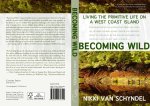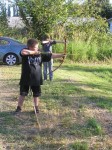How to Make Traditional Parfleche Rawhide & Tan Hides for Buckskin Leather
1. Gut & Skin Hide removing as much fat as possible, but not puncturing hide with knife. In fact, just make your initial cuts and PULL IT off. There is a youtube video at http://www.youtube.com/watch?v=9WzioyMC4qg that shows HOW TO GUT pretty well, but skip to this youtube video at http://www.youtube.com/watch?v=VLlU3l7YkTo for HOW TO SKIN a deer. Also look at the related recommended youtube videos that appear alongside these since people are always uploading new and better ones as time goes by. If you can’t work with the hide right away, then salt it and rollup in garbage bag, or freeze it. Freezing it for a year causes some hair slippage, so salt it if you want the hair/fur to stay on.
2. Flesh Hide on fleshing beam, using fairly dull draw knife, working neck-to-tail as much as possible to make the work a bit easier. If using a salted hide, then rinse it first very thoroughly, somewhere that the salt won’t effect the environment. If you can’t move to the next step right away, then freeze or resalt the hide for later. Check out these videos from Bowskin Archery & Buckskin for great in-depth descriptions:
3. Buck Hide to de-hair it easily and to help brains, eggs, etc. soak in when applied at a later stage. Again, if using a salted hide, rinse it first very thoroughly, somewhere that the salt won’t effect the environment. To buck, soak hide in a bucket or garbage can with a recipe of wood ash, lye, potassium hydroxide or soap – being careful to protect your eyes and hands/skin or from products containing lye. Stir several times per day until hair starts to fall out. Here’s the next in the video series from Bowskin Archery & Buckskin:
4. Rinse Hide until no longer slippery. Don’t wait between the bucking and rinsing stage. After rinsing thoroughly to protect the environment, submerge the hide in a stream if possible. If not available, you really have to hand rinse the hide in many changes of water. This could take a few minutes or a few days to not feel slippery. When the hair starts coming out in the stream, remove the hide and rinse in vinegar if you bucked the hide with ash, lye or other acidic solution. Vinegar will restore a good Ph balance. Wring the hide until it no longer drips. If you can’t work on it any further, you can dry or freeze the hide, but you can’t salt it now. Here’s the next video from Bowskin Archery & Buckskin:
5. Sew & Scrape/Grain Hide. Sew up any holes in the hide, unless near the edges. If working on it right away, or if you froze and thawed your hide, then “wet scrape” both sides of the hide on your fleshing beam, using your fairly dull draw knife. If you dried your hide (warm upstairs area with airflow) then “dry scrape” both sides of your hide using a fairly dull scraper so as to not cut the hide. You need to scrape both sides, until the epidermis (first skin layer under the skin) is off the outside, as well as all remnant fatty layers off the inside. If you need to stop dry scraping, try not to let the hide get wet before you return. If you need to stop wet scraping, or if you are done and can’t return to it for a few days, then either freeze or dry the hide, and begin this step again if not fully scraped. Here are the next videos from Bowskin Archery & Buckskin:
6. Soak Rawhide. Once scraped, you now have rawhide. You can rinse the hide and use it wet to make parfleche, drums, and other crafts; or continue with the tanning process by soaking the hide in eggs or tanning agents like acorn water. Again, dry or freeze to preserve if necessary for later use. The next time you have a few hours, then soak the hide in warm water (not too hot which would break down the hide proteins) and wring it out as best you can, then dress the hide with emulsified oils (found in eggs and brains). For eggs, mix a dozen in a cup hot water (average deer hide size) in a bucket, and work the hide around in the mixture; wring it above the bucket, cable it if possible, work it back in the remaining egg mixture again. Next video in the series from Bowskin Archery & Buckskin:
7. Wring, Rack, Rub & Stretch Hide. Your tanning station which should be in a low humidity, warm place with plenty of airflow, like on a breezy summer afternoon or in a wood-stove heated barn with good ceiling fan. Don’t rinse the egged hide; just wring it out, rack it up by punching holes around edges, and tie to square frame. Rub the hide and keep rubbing it super super hard with a rounded wooden handle, well past when you are exhausted (drink water, eat food) until it is dry buckskin. Don’t stop before all spots are free of moisture. You can rest now as long as the hide doesn’t ever get moist; otherwise, if it gets wet, it will go back to the rawhide stage. This is your big step, and Bowskin Archery & Buckskin splits the step into 3 videos:
8. Buff Hide. You can now get that fluffy buckskin feel by either 1) rubbing the hide back-and-forth over a thick cable tied between two points; or 2) more preferably, rubbing the hide with a pumice stone, which you can often buy in the bath area of department stores, or just find a stone that buffs well as long as it doesn’t leave residue; or 3) putting the hide in a dry area of your dwelling where people will often walk on it with bare feet. Again, you can stop when it’s as nice as you want it, but you still can’t get it wet.
9. Smoke Hide. This is how buckskin gets preserved from wetness, and becomes durable leather. It’s tricky; very tricky. Reason being: you can accidentally burn it up, like I did the first time I tried it back in ’98 as it really needs visual instruction, so I’m not going to describe the process here. Instead, take a look at these video examples:
A bit longer written description of the traditional tanning process with pictures can be found at http://braintanned.com/howto.html
A good place to buy rawhide if you don’t hunt your own deer ($45 – ask for buck or doe size with as few holes as possible) and green hides ($15 – 10 s.f. or larger) although you have to convince them that yes, you really want green hides, too: Centralia Fur & Hide, 2012 Gallagher Road, Centralia, WA, (360) 736-3663
Chris Chisholm is founder and co-owner of Wolf Camp & School of Natural Science. For in-depth learning, join our Weekly Online Classes:
- Tuesday Classes focus on Herbal Medicine & Plant Crafts in the autumn season, followed by Gardening & Cooking Wild Edible Food Plants in the spring.
- Thursday Classes focus on Wilderness Survival & Bushcraft Skills in the Autumn Season, followed by Wildlife Tracking & Birding in the spring.
- Saturday Classes for all ages guide you through the Wolf Journey Earth Conservation Course – Book One: The Neighborhood Naturalist.












